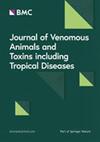A biocomplex to repair experimental critical size defects associated with photobiomodulation therapy
IF 1.8
3区 医学
Q4 TOXICOLOGY
Journal of Venomous Animals and Toxins Including Tropical Diseases
Pub Date : 2022-02-14
DOI:10.1590/1678-9199-JVATITD-2021-0056
引用次数: 5
Abstract
Abstract Background: The association of scaffolds to repair extensive bone defects can contribute to their evolution and morphophysiological recomposition. The incorporation of particulate biomaterials into three-dimensional fibrin bioproducts together with photobiomodulation therapy (PBM) has potential and can improve regenerative medicine procedures. The objective of this experiment was to evaluate the effects of PBM therapy on critical size defects filled with xenogenic bone substitute associated with fibrin biopolymer. Methods: A critical defect of 8 mm was performed in 36 Wistar male adult rats that were divided into four groups. Groups BC and BC-PBM were defined as controls with defects filled by a clot (without or with PBM, respectively) and groups XS and XS-PBM that comprised those filled with biocomplex Bio-OssTM in association with fibrin biopolymer. PBM was applied immediately after the surgery and three times a week every other day, with the parameters: wavelength of 830 nm, energy density 6.2 J/cm2, output power 30 mW, beam area of 0.116 cm2, irradiance 0.258,62 W/cm2, energy/point 0.72 J, total energy 2.88 J. Fourteen and 42 days after the surgery, animals were euthanatized and subjected to microtomography, qualitative and quantitative histological analysis. Results: The BC-PBM and XS-PBM groups had a similar evolution in the tissue repair process, with a higher density of the volume of new formed bone in relation to the groups without PBM (p = 0.04086; p = 0.07093, respectively). Intense vascular proliferation and bone deposition around the biomaterial particles were observed in the animals of the groups in which biocomplex was applied (XS and XS-PBM). Conclusion: PBM therapy allowed an improvement in the formation of new bone, with a more organized deposition of collagen fibers in the defect area. Biocomplex favored the insertion and permanence of the particulate material in bone defects, creating a favorable microenvironment for accelerate repair process.修复与光生物调节疗法相关的实验性临界尺寸缺陷的生物复合物
摘要背景:支架修复广泛骨缺损的作用可能与支架的进化和形态生理重构有关。将颗粒生物材料与光生物调节疗法(PBM)结合到三维纤维蛋白生物制品中,具有改善再生医学程序的潜力。本实验的目的是评估PBM治疗与纤维蛋白生物聚合物相关的异种骨替代物填充的临界尺寸缺陷的效果。方法:将36只Wistar雄性成年大鼠分为4组,取8 mm的临界缺损。BC组和BC-PBM组定义为由血块填充缺陷的对照组(分别为不含或含PBM), XS组和XS-PBM组由与纤维蛋白生物聚合物相关的生物复合物Bio-OssTM填充的对照组组成。术后立即应用PBM,每隔一天应用3次,每周3次,参数为:波长830 nm,能量密度6.2 J/cm2,输出功率30 mW,光束面积0.116 cm2,辐照度0.258,62 W/cm2,能量/点0.72 J,总能量2.88 J。术后14和42 d,安乐死动物,进行显微断层扫描,定性和定量组织学分析。结果:BC-PBM组和XS-PBM组在组织修复过程中具有相似的进化,新形成骨的体积密度高于未PBM组(p = 0.04086;P = 0.07093)。应用生物复合物(XS和XS- pbm)组的动物在生物材料颗粒周围观察到强烈的血管增生和骨沉积。结论:PBM治疗可以改善新骨的形成,在缺损区域胶原纤维的沉积更有组织。生物复合物有利于颗粒材料在骨缺损中的插入和永久性,为加速修复过程创造了有利的微环境。
本文章由计算机程序翻译,如有差异,请以英文原文为准。
求助全文
约1分钟内获得全文
求助全文
来源期刊
CiteScore
4.80
自引率
8.30%
发文量
39
审稿时长
6-12 weeks
期刊介绍:
Journal of Venomous Animals and Toxins including Tropical Diseases (JVATiTD) is a non-commercial academic open access publication dedicated to research on all aspects of toxinology, venomous animals and tropical diseases. Its interdisciplinary content includes original scientific articles covering research on toxins derived from animals, plants and microorganisms. Topics of interest include, but are not limited to:systematics and morphology of venomous animals;physiology, biochemistry, pharmacology and immunology of toxins;epidemiology, clinical aspects and treatment of envenoming by different animals, plants and microorganisms;development and evaluation of antivenoms and toxin-derivative products;epidemiology, clinical aspects and treatment of tropical diseases (caused by virus, bacteria, algae, fungi and parasites) including the neglected tropical diseases (NTDs) defined by the World Health Organization.

 求助内容:
求助内容: 应助结果提醒方式:
应助结果提醒方式:


